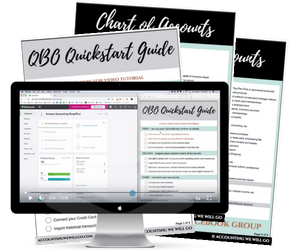What terminology do Amazon Sellers need to know when importing inventory?
Many Amazon sellers have found success in importing inventory – whether to resell “as is” or to private label under their own brand. While it can be fun and exciting to know your shipment is on the way from China (or wherever you are importing from,) it’s not as simple as going online, placing an order, and waiting for sales to roll in. (If only!)
Are you familiar with Incoterms, the Harmonized Tariff Schedule, or what a Customs Broker actually does? If not, this guide should help you as you are considering importing or plan to grow your import business.
In the meantime, please be sure your books are in order. If you need help getting started, we will help you set up a QuickBooks Online Account for your Amazon business for FREE! This link includes access to a guide, a video tutorial, and a downloadable Chart of Accounts, specific to e-commerce sellers.
NEED HELP WITH YOUR QBO SETUP?
Grab our FREE QBO Quickstart Guide with video tutorial and Chart of Accounts.
First, some history!
While importing may be new to you, as an Amazon or eBay seller, it is not new to the world. Marco Polo (1254-1324) was one of the first and most famous Europeans to travel to Asia during the Middle Ages. He traveled farther than any of his predecessors during his 24-year journey along the Silk Road, reaching China and Mongolia, where he became a confidant of Kublai Khan.
My favorite Marco Polo fact is that he was one of the first Europeans to see a rhinoceros. (However, he thought they were unicorns.)
Next, a vocabulary lesson!
When importing inventory from another country, it is important to understand "Incoterms.” While some inventory sellers simply sit down, go on one of several popular websites, (Alibaba is a popular resource,) surf around, and then place an order, there are behind the scenes details that are important to be familiar with. Even if you are not placing large orders in shipping containers that weigh tons and take months to arrive, you still need to understand Incomterms.
Incoterms are the Rules for international trade by any mode of transport defined by Incoterms® 2010.
The US Government has a nice overview of incoterms here:
https://www.export.gov/article?id=Incoterms-Overview
Incoterms clearly assign shipping responsibilities. Using Incoterms will help avoid misunderstandings resulting in lost money, lost inventory, disappointment, and strained relationships.
These are some of the most important Incoterms to understand and will clarify who is responsible for the goods and services under contract at each stage of the importing process.
EXW – Ex Works (named place)
The seller makes the goods available at its premises. This term places the maximum obligation on the buyer and minimum obligations on the seller. The Ex Works term is often used when making an initial quotation for the sale of goods without any costs included. EXW means that a seller has the goods ready for collection at his premises (works, factory, warehouse, plant) on the date agreed upon. The buyer pays all transportation costs and also bears the risks for bringing the goods to their final destination. The seller doesn’t load the goods on collecting vehicles and doesn’t clear them for export. If the seller does load the goods, he does so at buyer’s risk and cost. If parties wish seller to be responsible for the loading of the goods on departure and to bear the risk and all costs of such loading, this must be made clear by adding explicit wording to this effect in the contract of sale.
FCA – Free Carrier (named place)
The seller hands over the goods, cleared for export, into the disposal of the first carrier (named by the buyer) at the named place. The seller pays for carriage to the named point of delivery, and risk passes when the goods are handed over to the first carrier.
CPT – Carriage Paid To (named place of destination)
The seller pays for carriage. Risk transfers to buyer upon handing goods over to the first carrier.
CIP – Carriage and Insurance Paid to (named place of destination)
The containerized transport/multimodal equivalent of CIF. Seller pays for carriage and insurance to the named destination point, but risk passes when the goods are handed over to the first carrier.
DAT – Delivered at Terminal (named terminal at port or place of destination)
Seller pays for carriage to the terminal, except for costs related to import clearance, and assumes all risks up to the point that the goods are unloaded at the terminal.
DAP – Delivered at Place (named place of destination)
Seller pays for carriage to the named place, except for costs related to import clearance, and assumes all risks prior to the point that the goods are ready for unloading by the buyer.
DDP – Delivered Duty Paid (named place of destination)
Seller is responsible for delivering the goods to the named place in the country of the buyer, and pays all costs in bringing the goods to the destination including import duties and taxes. This term places the maximum obligations on the seller and minimum obligations on the buyer.
Rules for international trade conducted entirely by water defined by Incoterms® 2010
FAS – Free Alongside Ship (named port of shipment)
The seller must place the goods alongside the ship at the named port. The seller must clear the goods for export. Suitable only for maritime transport but NOT for multimodal sea transport in containers (see Incoterms 2010, ICC publication 715). This term is typically used for heavy-lift or bulk cargo.
FOB – Free On Board (named port or place of shipment)
The seller must load the goods on board the vessel nominated by the buyer. Cost and risk are divided when the goods are actually on board of the vessel (this rule is new!). The seller must clear the goods for export. The term is applicable for maritime and inland waterway transport only but NOT for multimodal sea transport in containers (see Incoterms 2010, ICC publication 715). This Term has been greatly misused over the last three decades, ever since Incoterms 1980 explained that FCA should be used for container shipments.
CFR – Cost and Freight (named port of destination)
Seller must pay the costs and freight to bring the goods to the port of destination. However, risk is transferred to the buyer once the goods are loaded on the vessel (this rule is new!). Maritime transport only and Insurance for the goods is NOT included. This term was formerly known as CNF (C&F).
CIF – Cost, Insurance and Freight (named port of destination)
Exactly the same as CFR except that the seller must in addition procure and pay for the insurance. (Maritime transport only.)
Now that you have an introduction to the the key Incoterms you should be familiar with, you should consider hiring a customs broker.
What is a customs broker?
Customs brokers help sellers navigate the complicated customs clearance process. From the U.S. Customs and Border Protection Service: Customs brokers are private individuals, partnerships, associations or corporations licensed, regulated and empowered by U.S. Customs and Border Protection (CBP) to assist importers and exporters in meeting Federal requirements governing imports and exports. Brokers submit necessary information and appropriate payments to CBP on behalf of their clients and charge them a fee for this service.
Brokers must have expertise in the entry procedures, admissibility requirements, classification, valuation, and the rates of duty and applicable taxes and fees for imported merchandise.
There are approximately 11,000 active licensed Customs brokers in the United States. If you are considering using a Customs broker, be sure they are actively licensed.
What is the Harmonized Tariff Schedule and why does it matter to me?
The Harmonized Tariff Schedule (HTS) is a 10-digit classification system specific to importing in the United States.
As explained by the International Trade Commission: The HTS of the United States was enacted by Congress and made effective on January 1, 1989, replacing the former Tariff Schedules of the United States.
The HTS comprises a hierarchical structure for describing all goods in trade for duty, quota, and statistical purposes. This structure is based upon the international Harmonized Commodity Description and Coding System (HS), administered by the World Customs Organization in Brussels ; the 4- and 6-digit HS product categories are subdivided into 8-digit unique U.S. rate lines and 10-digit non-legal statistical reporting categories. Classification of goods in this system must be done in accordance with the General and Additional U.S. Rules of Interpretation, starting at the 4-digit heading level to find the most specific provision and then moving to the subordinate categories.
Essentially the HTS is the internationally accepted system used to classify traded products, and when you are importing to the United States, you must know the HTS code associated with the inventory you are importing.
If you do not know which HTS code applies, please do not just “ask around on Facebook” in your favorite e-commerce selling group. It is really important to get the HTS code right. You can call the local field office of the US Customs and Border Protection Service and they will help you. Or, your customs broker can tell you.
The HTS is important because it is used by all countries. Duties and tariffs are established based on the HTS code. Without a proper code, your inventory may be delayed at customs in both the exporting and importing country. Even worse, you may be assessed a fine or more expensive tariffs, adding to shipping costs which could result in unprofitable inventory.
A few final words
Now that you have familiarized yourself with important terminology and jargon related to importing inventory for your e-commerce business, you should feel more confident as you begin next steps. I recommend that you do your own due diligence and make sure you understand your responsibilities and the responsibilities of the exporter you are buying inventory from. This guide is for reference only. In addition to working with a licensed customs broker and other professionals as needed, I also recommend you ask for mentoring or advice from an experienced importer. People learn by doing, and are often happy to share what they have learned with others who are less experienced.
And, as always, be SURE you have your books up to date. You can’t manage what you don’t measure, and it’s almost impossible to grow a successful inventory sales business if you do not know your numbers! If you want to start with a firm foundation, enter your information below to download our FREE QBO Quickstart Guide to get you started using QuickBooks Online, including a video tutorial and Chart of Accounts specific to your Amazon business.




